Education Report: Developing Math Computational Skills Analysis
VerifiedAdded on 2023/06/09
|36
|9074
|437
Report
AI Summary
This report investigates the development of math computational skills, focusing on math fact fluency and its impact on higher-order math skills. The study includes a needs assessment of Chester A. Moore Elementary, a school in St. Lucie County, Florida, highlighting the school's demographics and student-teacher ratio. The report synthesizes literature on improving math fluency, exploring various methods such as extra-curricular classes, computer programs, and cognitive strategies. It also addresses teaching children with mild intellectual disabilities, suggesting individualized programs and game-based learning. The report emphasizes the importance of teacher involvement and the use of electronic tools. The study aims to identify the connection between math fact fluency and oral activities, and how to enhance the process of math fluency. The report includes details on the research methodology, study design, implementation, data collection, and ethical considerations. The evaluation plan is also included in the report. The school uses IReady Math & Reading program to enhance students learning abilities.
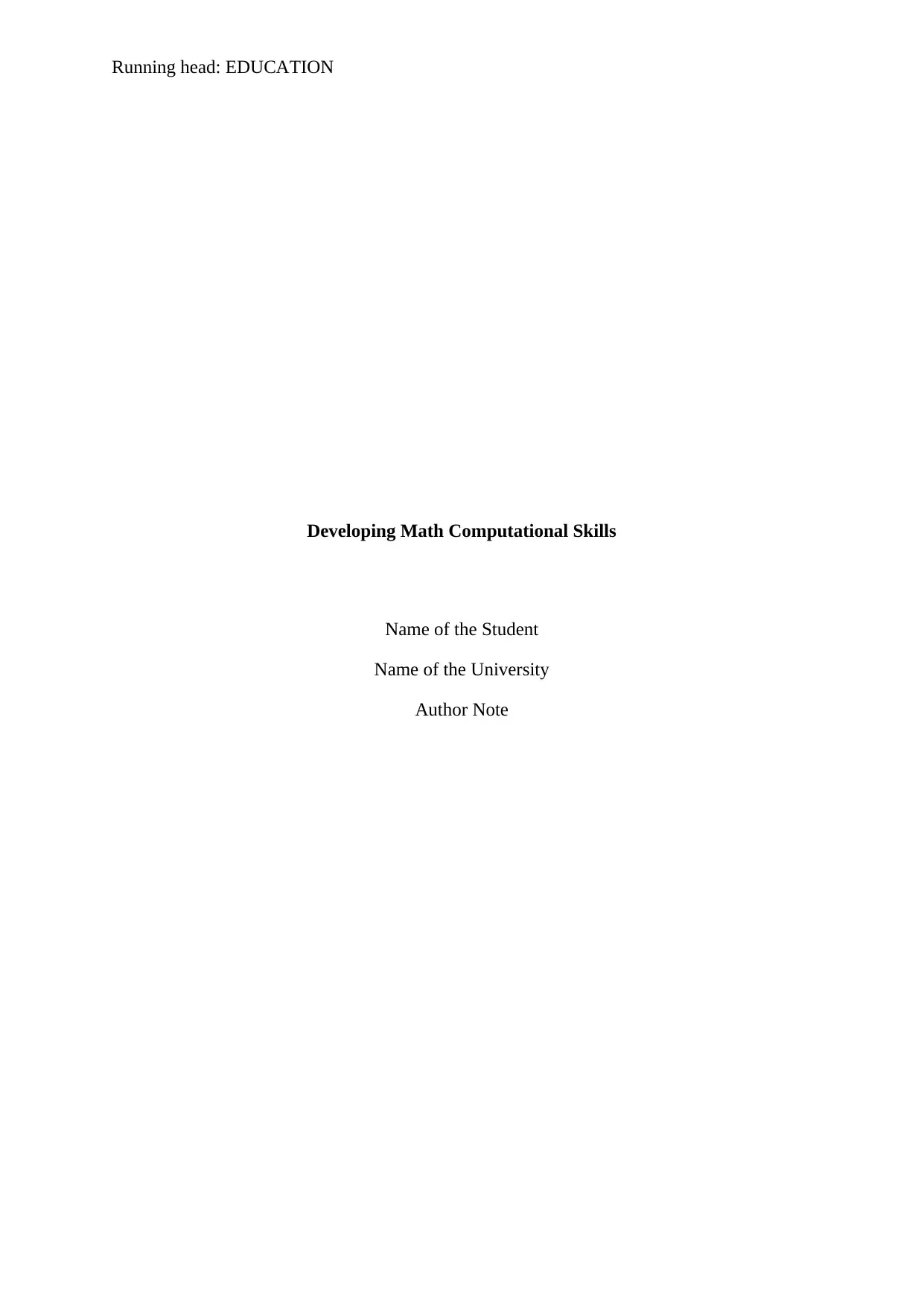
Running head: EDUCATION
Developing Math Computational Skills
Name of the Student
Name of the University
Author Note
Developing Math Computational Skills
Name of the Student
Name of the University
Author Note
Paraphrase This Document
Need a fresh take? Get an instant paraphrase of this document with our AI Paraphraser
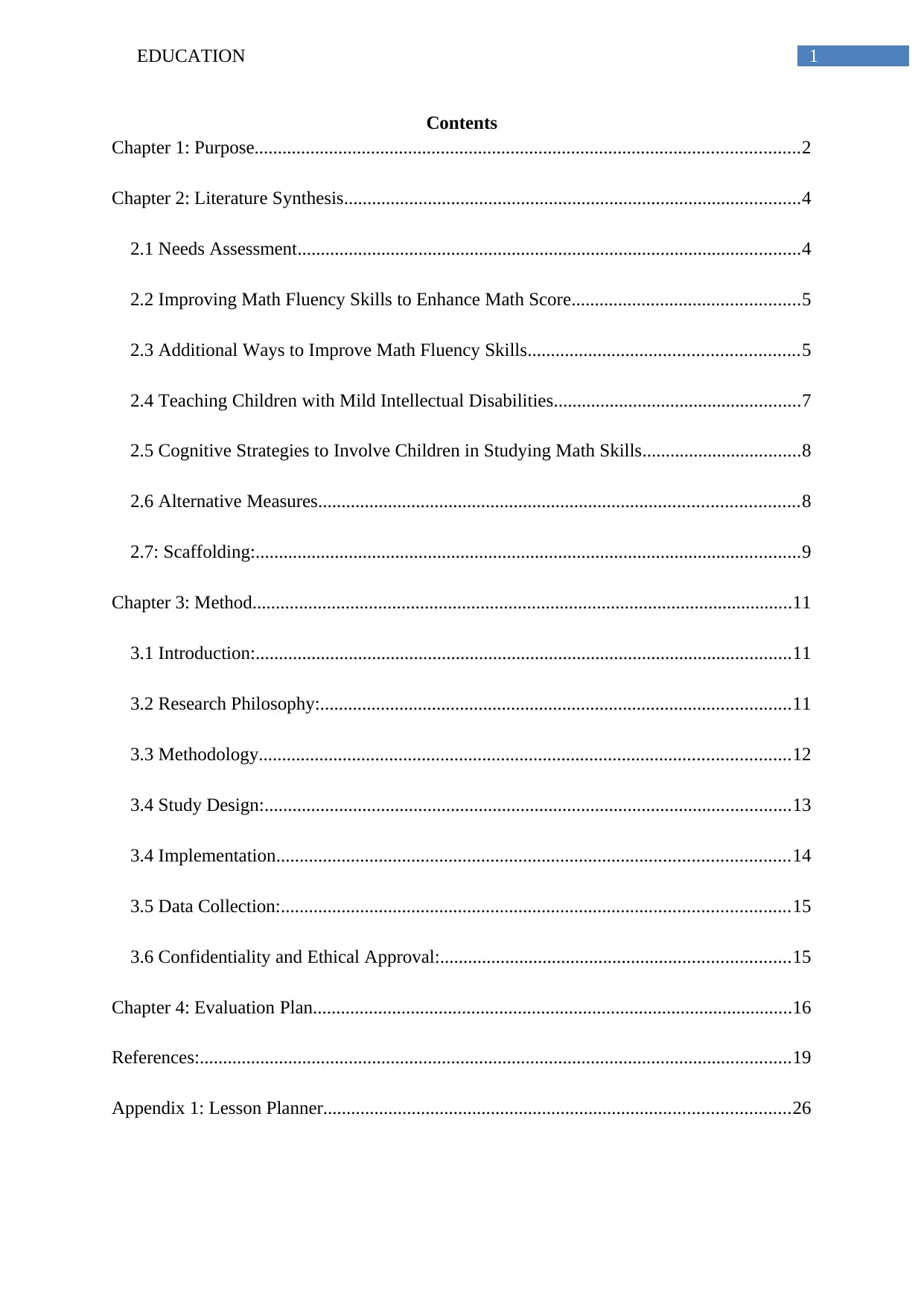
1EDUCATION
Contents
Chapter 1: Purpose.....................................................................................................................2
Chapter 2: Literature Synthesis..................................................................................................4
2.1 Needs Assessment............................................................................................................4
2.2 Improving Math Fluency Skills to Enhance Math Score.................................................5
2.3 Additional Ways to Improve Math Fluency Skills..........................................................5
2.4 Teaching Children with Mild Intellectual Disabilities.....................................................7
2.5 Cognitive Strategies to Involve Children in Studying Math Skills..................................8
2.6 Alternative Measures.......................................................................................................8
2.7: Scaffolding:.....................................................................................................................9
Chapter 3: Method....................................................................................................................11
3.1 Introduction:...................................................................................................................11
3.2 Research Philosophy:.....................................................................................................11
3.3 Methodology..................................................................................................................12
3.4 Study Design:.................................................................................................................13
3.4 Implementation..............................................................................................................14
3.5 Data Collection:.............................................................................................................15
3.6 Confidentiality and Ethical Approval:...........................................................................15
Chapter 4: Evaluation Plan.......................................................................................................16
References:...............................................................................................................................19
Appendix 1: Lesson Planner....................................................................................................26
Contents
Chapter 1: Purpose.....................................................................................................................2
Chapter 2: Literature Synthesis..................................................................................................4
2.1 Needs Assessment............................................................................................................4
2.2 Improving Math Fluency Skills to Enhance Math Score.................................................5
2.3 Additional Ways to Improve Math Fluency Skills..........................................................5
2.4 Teaching Children with Mild Intellectual Disabilities.....................................................7
2.5 Cognitive Strategies to Involve Children in Studying Math Skills..................................8
2.6 Alternative Measures.......................................................................................................8
2.7: Scaffolding:.....................................................................................................................9
Chapter 3: Method....................................................................................................................11
3.1 Introduction:...................................................................................................................11
3.2 Research Philosophy:.....................................................................................................11
3.3 Methodology..................................................................................................................12
3.4 Study Design:.................................................................................................................13
3.4 Implementation..............................................................................................................14
3.5 Data Collection:.............................................................................................................15
3.6 Confidentiality and Ethical Approval:...........................................................................15
Chapter 4: Evaluation Plan.......................................................................................................16
References:...............................................................................................................................19
Appendix 1: Lesson Planner....................................................................................................26
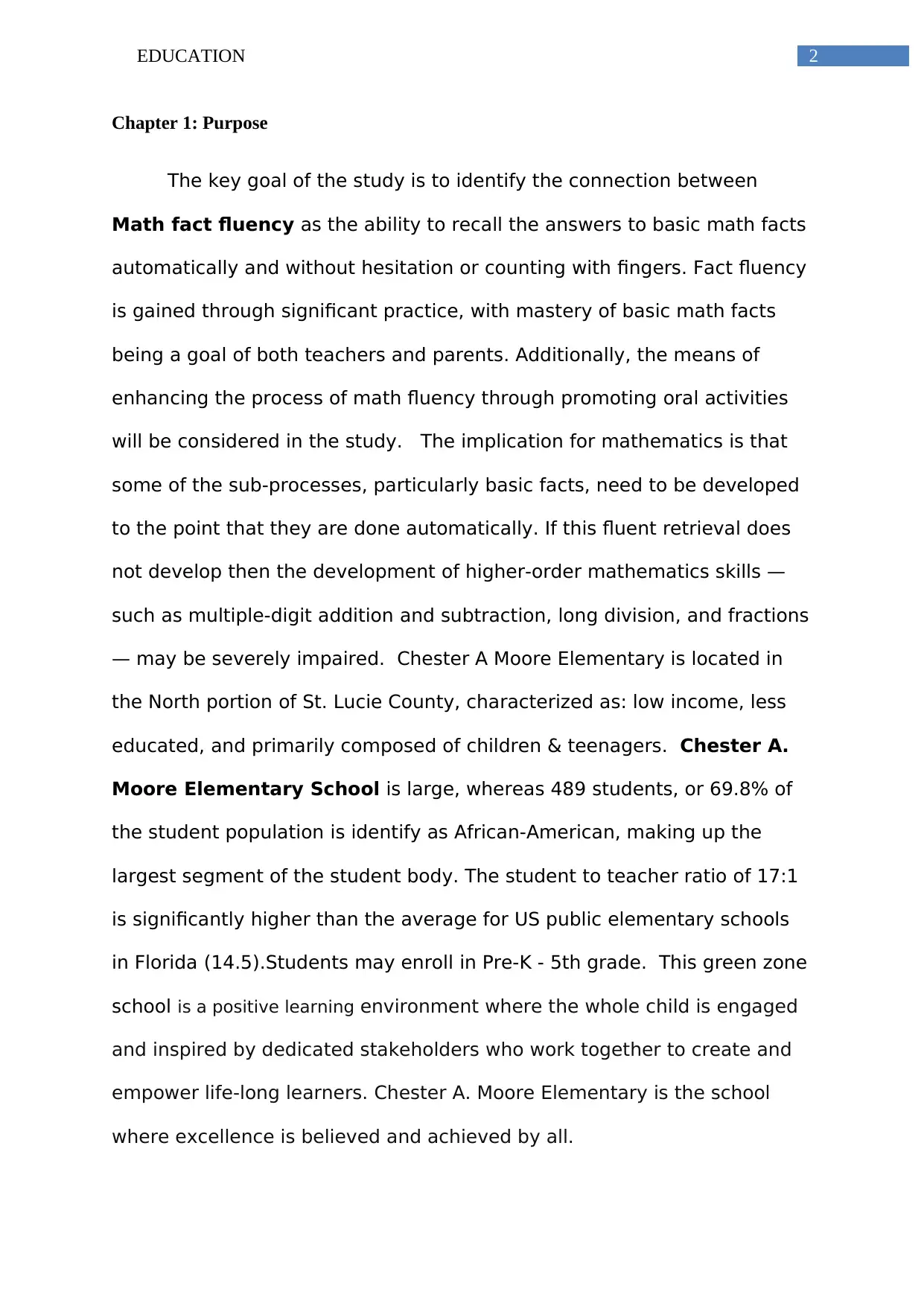
2EDUCATION
Chapter 1: Purpose
The key goal of the study is to identify the connection between
Math fact fluency as the ability to recall the answers to basic math facts
automatically and without hesitation or counting with fingers. Fact fluency
is gained through significant practice, with mastery of basic math facts
being a goal of both teachers and parents. Additionally, the means of
enhancing the process of math fluency through promoting oral activities
will be considered in the study. The implication for mathematics is that
some of the sub-processes, particularly basic facts, need to be developed
to the point that they are done automatically. If this fluent retrieval does
not develop then the development of higher-order mathematics skills —
such as multiple-digit addition and subtraction, long division, and fractions
— may be severely impaired. Chester A Moore Elementary is located in
the North portion of St. Lucie County, characterized as: low income, less
educated, and primarily composed of children & teenagers. Chester A.
Moore Elementary School is large, whereas 489 students, or 69.8% of
the student population is identify as African-American, making up the
largest segment of the student body. The student to teacher ratio of 17:1
is significantly higher than the average for US public elementary schools
in Florida (14.5).Students may enroll in Pre-K - 5th grade. This green zone
school is a positive learning environment where the whole child is engaged
and inspired by dedicated stakeholders who work together to create and
empower life-long learners. Chester A. Moore Elementary is the school
where excellence is believed and achieved by all.
Chapter 1: Purpose
The key goal of the study is to identify the connection between
Math fact fluency as the ability to recall the answers to basic math facts
automatically and without hesitation or counting with fingers. Fact fluency
is gained through significant practice, with mastery of basic math facts
being a goal of both teachers and parents. Additionally, the means of
enhancing the process of math fluency through promoting oral activities
will be considered in the study. The implication for mathematics is that
some of the sub-processes, particularly basic facts, need to be developed
to the point that they are done automatically. If this fluent retrieval does
not develop then the development of higher-order mathematics skills —
such as multiple-digit addition and subtraction, long division, and fractions
— may be severely impaired. Chester A Moore Elementary is located in
the North portion of St. Lucie County, characterized as: low income, less
educated, and primarily composed of children & teenagers. Chester A.
Moore Elementary School is large, whereas 489 students, or 69.8% of
the student population is identify as African-American, making up the
largest segment of the student body. The student to teacher ratio of 17:1
is significantly higher than the average for US public elementary schools
in Florida (14.5).Students may enroll in Pre-K - 5th grade. This green zone
school is a positive learning environment where the whole child is engaged
and inspired by dedicated stakeholders who work together to create and
empower life-long learners. Chester A. Moore Elementary is the school
where excellence is believed and achieved by all.
⊘ This is a preview!⊘
Do you want full access?
Subscribe today to unlock all pages.

Trusted by 1+ million students worldwide

3EDUCATION
Faculty and staff members embrace students through conferencing
as well as informal conversations throughout the school day. Individuals
are available to translate for families and students that do not speak
English. For students that do not speak English, the teacher assigns
another student that speaks the native language to assist the student
through peer tutoring. Parent teacher conferences are held to learn more
about students' cultures, heritage and backgrounds. Chester A. Moore is a
Kids at Hope school where all children are capable of success and the
faculty and staff is committed to the philosophy of the Kids at Hope
Initiative. Kids at Hope ensure that there is a caring adult in the lives of
the children. The adults on campus serve as those caring adults.
Chester A Moore Elementary is committed to our mission of
providing quality, standards-based instruction by providing the best
possible educational experience for all students in the safest possible
environment.
Chester A. Moore is committed to our vision that all students are
provided with exemplary instruction and learning opportunities in order to
prepare each child to advance to the next level in their pursuits of college
studies and careers.
In setting our goals, we will continue to strive towards higher levels
of student performance by offering a challenging elementary curriculum
that is aligned with rigorous standards delivered through diversified
instructional strategies.
Faculty and staff members embrace students through conferencing
as well as informal conversations throughout the school day. Individuals
are available to translate for families and students that do not speak
English. For students that do not speak English, the teacher assigns
another student that speaks the native language to assist the student
through peer tutoring. Parent teacher conferences are held to learn more
about students' cultures, heritage and backgrounds. Chester A. Moore is a
Kids at Hope school where all children are capable of success and the
faculty and staff is committed to the philosophy of the Kids at Hope
Initiative. Kids at Hope ensure that there is a caring adult in the lives of
the children. The adults on campus serve as those caring adults.
Chester A Moore Elementary is committed to our mission of
providing quality, standards-based instruction by providing the best
possible educational experience for all students in the safest possible
environment.
Chester A. Moore is committed to our vision that all students are
provided with exemplary instruction and learning opportunities in order to
prepare each child to advance to the next level in their pursuits of college
studies and careers.
In setting our goals, we will continue to strive towards higher levels
of student performance by offering a challenging elementary curriculum
that is aligned with rigorous standards delivered through diversified
instructional strategies.
Paraphrase This Document
Need a fresh take? Get an instant paraphrase of this document with our AI Paraphraser
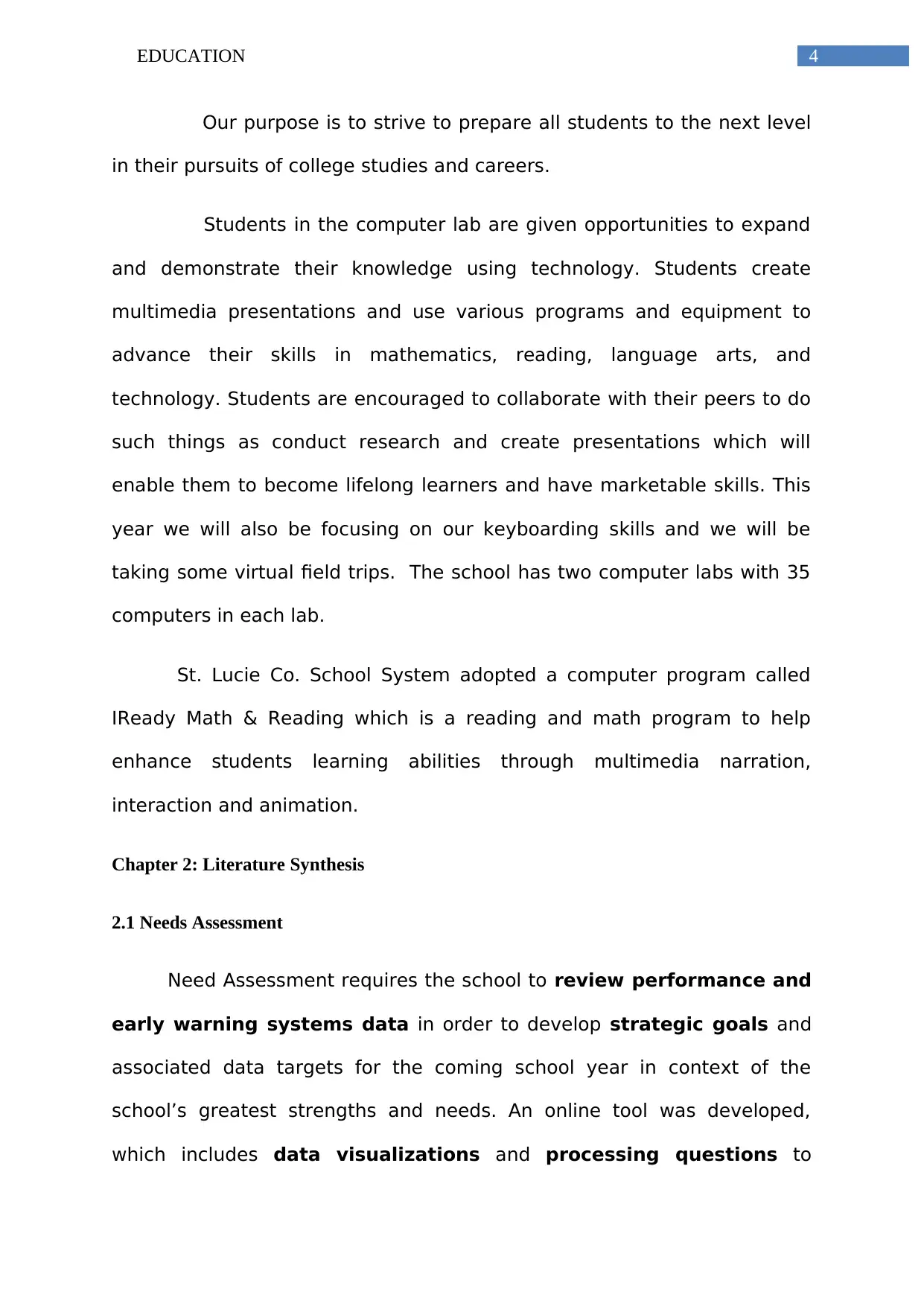
4EDUCATION
Our purpose is to strive to prepare all students to the next level
in their pursuits of college studies and careers.
Students in the computer lab are given opportunities to expand
and demonstrate their knowledge using technology. Students create
multimedia presentations and use various programs and equipment to
advance their skills in mathematics, reading, language arts, and
technology. Students are encouraged to collaborate with their peers to do
such things as conduct research and create presentations which will
enable them to become lifelong learners and have marketable skills. This
year we will also be focusing on our keyboarding skills and we will be
taking some virtual field trips. The school has two computer labs with 35
computers in each lab.
St. Lucie Co. School System adopted a computer program called
IReady Math & Reading which is a reading and math program to help
enhance students learning abilities through multimedia narration,
interaction and animation.
Chapter 2: Literature Synthesis
2.1 Needs Assessment
Need Assessment requires the school to review performance and
early warning systems data in order to develop strategic goals and
associated data targets for the coming school year in context of the
school’s greatest strengths and needs. An online tool was developed,
which includes data visualizations and processing questions to
Our purpose is to strive to prepare all students to the next level
in their pursuits of college studies and careers.
Students in the computer lab are given opportunities to expand
and demonstrate their knowledge using technology. Students create
multimedia presentations and use various programs and equipment to
advance their skills in mathematics, reading, language arts, and
technology. Students are encouraged to collaborate with their peers to do
such things as conduct research and create presentations which will
enable them to become lifelong learners and have marketable skills. This
year we will also be focusing on our keyboarding skills and we will be
taking some virtual field trips. The school has two computer labs with 35
computers in each lab.
St. Lucie Co. School System adopted a computer program called
IReady Math & Reading which is a reading and math program to help
enhance students learning abilities through multimedia narration,
interaction and animation.
Chapter 2: Literature Synthesis
2.1 Needs Assessment
Need Assessment requires the school to review performance and
early warning systems data in order to develop strategic goals and
associated data targets for the coming school year in context of the
school’s greatest strengths and needs. An online tool was developed,
which includes data visualizations and processing questions to
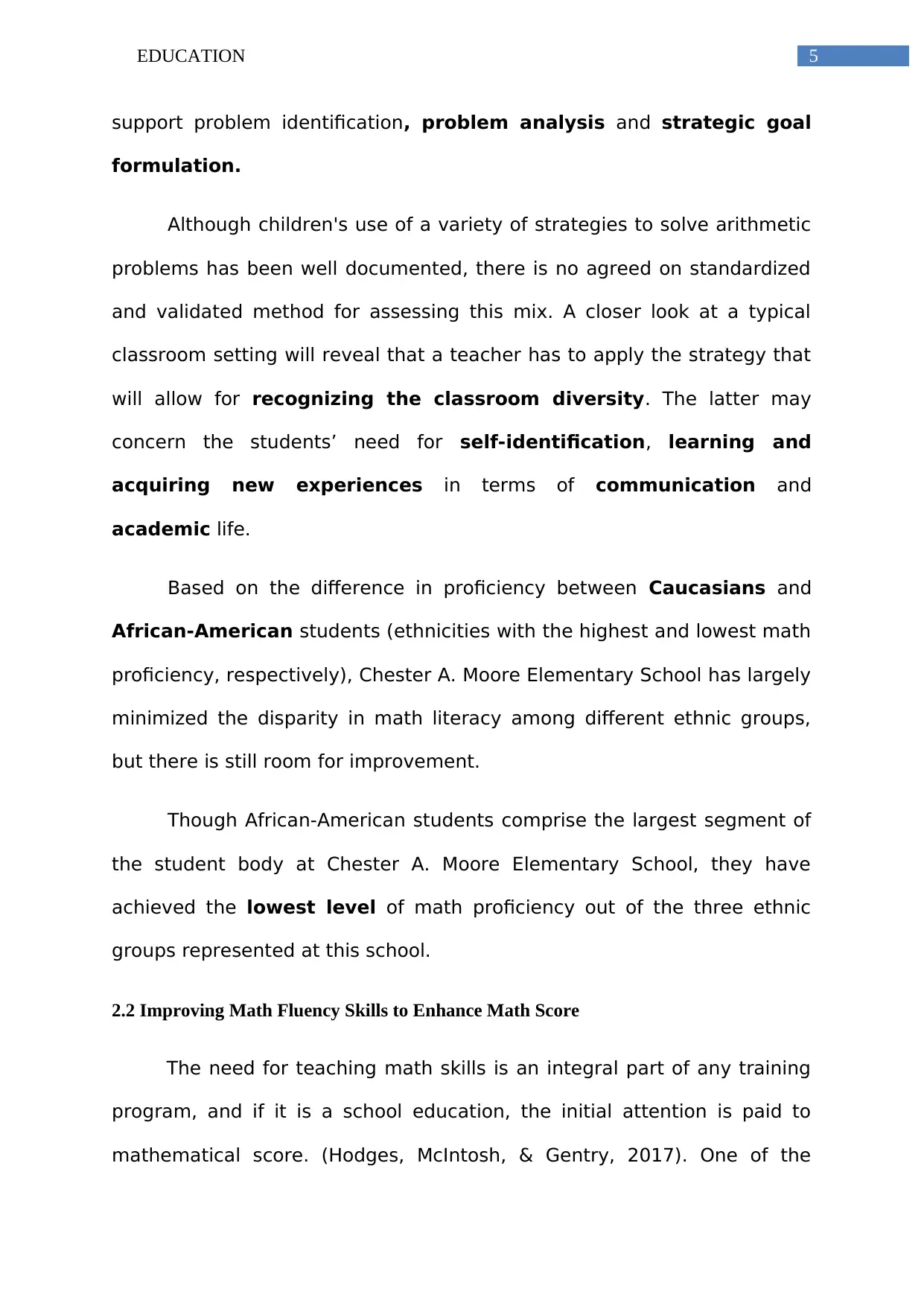
5EDUCATION
support problem identification, problem analysis and strategic goal
formulation.
Although children's use of a variety of strategies to solve arithmetic
problems has been well documented, there is no agreed on standardized
and validated method for assessing this mix. A closer look at a typical
classroom setting will reveal that a teacher has to apply the strategy that
will allow for recognizing the classroom diversity. The latter may
concern the students’ need for self-identification, learning and
acquiring new experiences in terms of communication and
academic life.
Based on the difference in proficiency between Caucasians and
African-American students (ethnicities with the highest and lowest math
proficiency, respectively), Chester A. Moore Elementary School has largely
minimized the disparity in math literacy among different ethnic groups,
but there is still room for improvement.
Though African-American students comprise the largest segment of
the student body at Chester A. Moore Elementary School, they have
achieved the lowest level of math proficiency out of the three ethnic
groups represented at this school.
2.2 Improving Math Fluency Skills to Enhance Math Score
The need for teaching math skills is an integral part of any training
program, and if it is a school education, the initial attention is paid to
mathematical score. (Hodges, McIntosh, & Gentry, 2017). One of the
support problem identification, problem analysis and strategic goal
formulation.
Although children's use of a variety of strategies to solve arithmetic
problems has been well documented, there is no agreed on standardized
and validated method for assessing this mix. A closer look at a typical
classroom setting will reveal that a teacher has to apply the strategy that
will allow for recognizing the classroom diversity. The latter may
concern the students’ need for self-identification, learning and
acquiring new experiences in terms of communication and
academic life.
Based on the difference in proficiency between Caucasians and
African-American students (ethnicities with the highest and lowest math
proficiency, respectively), Chester A. Moore Elementary School has largely
minimized the disparity in math literacy among different ethnic groups,
but there is still room for improvement.
Though African-American students comprise the largest segment of
the student body at Chester A. Moore Elementary School, they have
achieved the lowest level of math proficiency out of the three ethnic
groups represented at this school.
2.2 Improving Math Fluency Skills to Enhance Math Score
The need for teaching math skills is an integral part of any training
program, and if it is a school education, the initial attention is paid to
mathematical score. (Hodges, McIntosh, & Gentry, 2017). One of the
⊘ This is a preview!⊘
Do you want full access?
Subscribe today to unlock all pages.

Trusted by 1+ million students worldwide
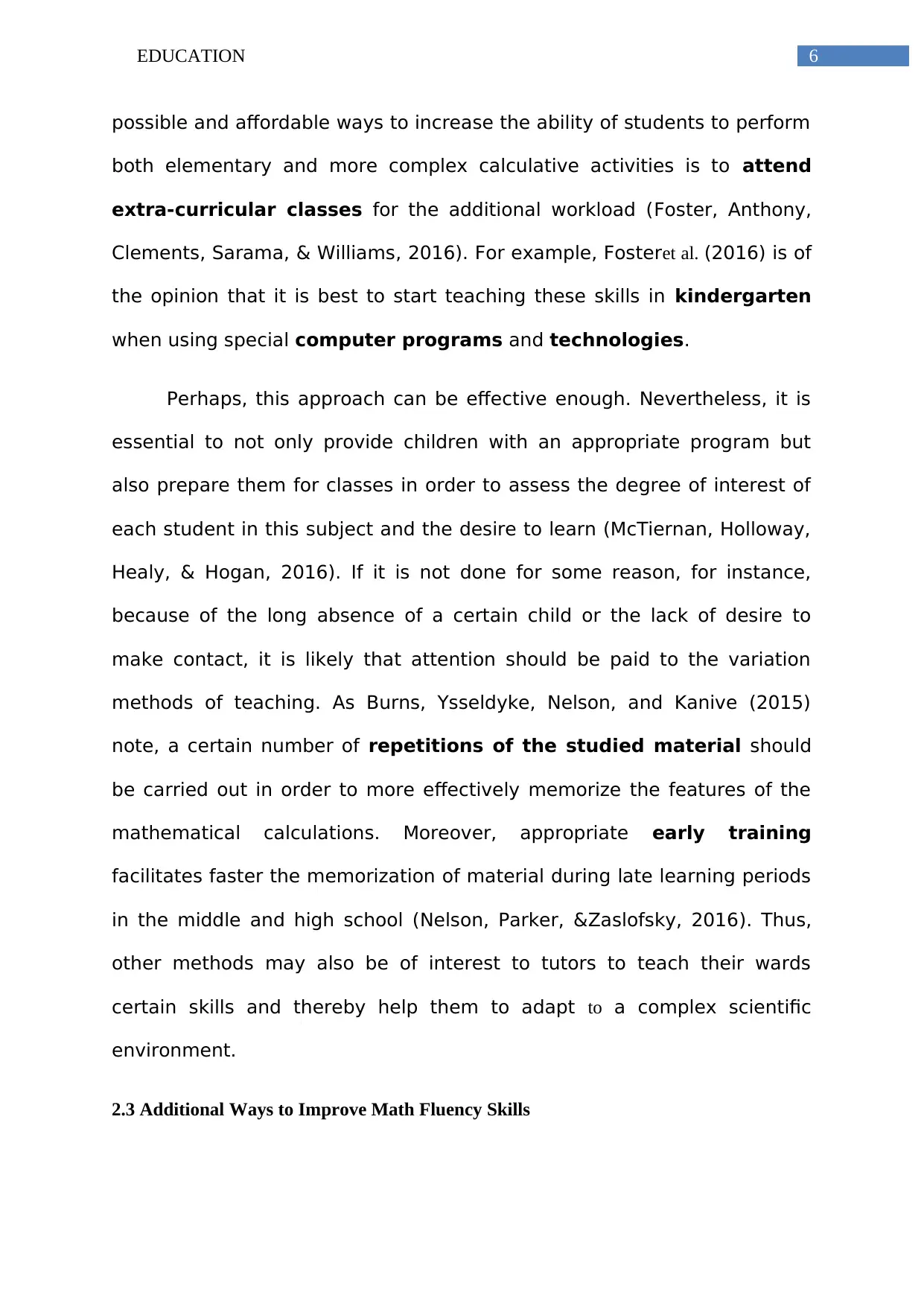
6EDUCATION
possible and affordable ways to increase the ability of students to perform
both elementary and more complex calculative activities is to attend
extra-curricular classes for the additional workload (Foster, Anthony,
Clements, Sarama, & Williams, 2016). For example, Fosteret al. (2016) is of
the opinion that it is best to start teaching these skills in kindergarten
when using special computer programs and technologies.
Perhaps, this approach can be effective enough. Nevertheless, it is
essential to not only provide children with an appropriate program but
also prepare them for classes in order to assess the degree of interest of
each student in this subject and the desire to learn (McTiernan, Holloway,
Healy, & Hogan, 2016). If it is not done for some reason, for instance,
because of the long absence of a certain child or the lack of desire to
make contact, it is likely that attention should be paid to the variation
methods of teaching. As Burns, Ysseldyke, Nelson, and Kanive (2015)
note, a certain number of repetitions of the studied material should
be carried out in order to more effectively memorize the features of the
mathematical calculations. Moreover, appropriate early training
facilitates faster the memorization of material during late learning periods
in the middle and high school (Nelson, Parker, &Zaslofsky, 2016). Thus,
other methods may also be of interest to tutors to teach their wards
certain skills and thereby help them to adapt to a complex scientific
environment.
2.3 Additional Ways to Improve Math Fluency Skills
possible and affordable ways to increase the ability of students to perform
both elementary and more complex calculative activities is to attend
extra-curricular classes for the additional workload (Foster, Anthony,
Clements, Sarama, & Williams, 2016). For example, Fosteret al. (2016) is of
the opinion that it is best to start teaching these skills in kindergarten
when using special computer programs and technologies.
Perhaps, this approach can be effective enough. Nevertheless, it is
essential to not only provide children with an appropriate program but
also prepare them for classes in order to assess the degree of interest of
each student in this subject and the desire to learn (McTiernan, Holloway,
Healy, & Hogan, 2016). If it is not done for some reason, for instance,
because of the long absence of a certain child or the lack of desire to
make contact, it is likely that attention should be paid to the variation
methods of teaching. As Burns, Ysseldyke, Nelson, and Kanive (2015)
note, a certain number of repetitions of the studied material should
be carried out in order to more effectively memorize the features of the
mathematical calculations. Moreover, appropriate early training
facilitates faster the memorization of material during late learning periods
in the middle and high school (Nelson, Parker, &Zaslofsky, 2016). Thus,
other methods may also be of interest to tutors to teach their wards
certain skills and thereby help them to adapt to a complex scientific
environment.
2.3 Additional Ways to Improve Math Fluency Skills
Paraphrase This Document
Need a fresh take? Get an instant paraphrase of this document with our AI Paraphraser
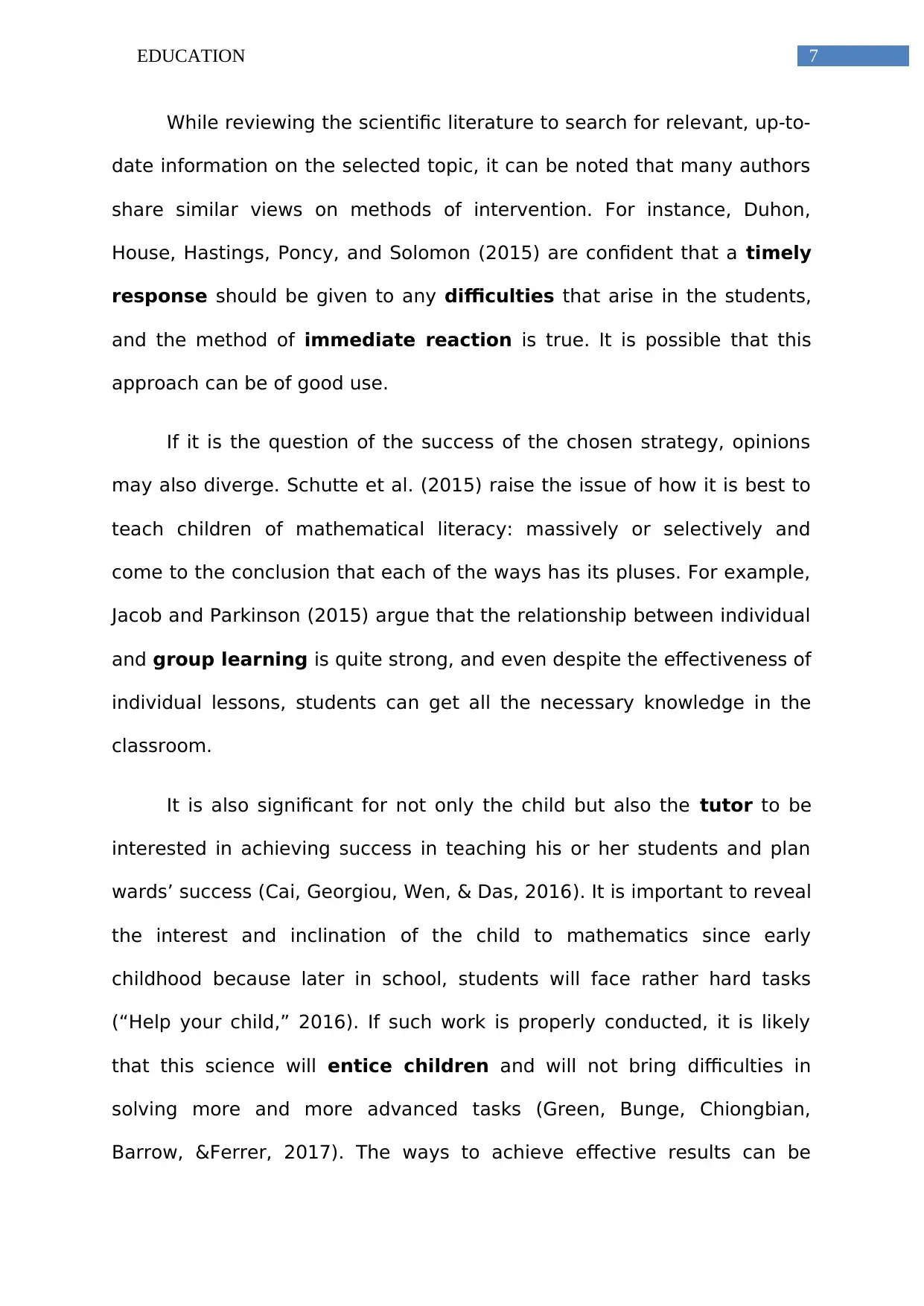
7EDUCATION
While reviewing the scientific literature to search for relevant, up-to-
date information on the selected topic, it can be noted that many authors
share similar views on methods of intervention. For instance, Duhon,
House, Hastings, Poncy, and Solomon (2015) are confident that a timely
response should be given to any difficulties that arise in the students,
and the method of immediate reaction is true. It is possible that this
approach can be of good use.
If it is the question of the success of the chosen strategy, opinions
may also diverge. Schutte et al. (2015) raise the issue of how it is best to
teach children of mathematical literacy: massively or selectively and
come to the conclusion that each of the ways has its pluses. For example,
Jacob and Parkinson (2015) argue that the relationship between individual
and group learning is quite strong, and even despite the effectiveness of
individual lessons, students can get all the necessary knowledge in the
classroom.
It is also significant for not only the child but also the tutor to be
interested in achieving success in teaching his or her students and plan
wards’ success (Cai, Georgiou, Wen, & Das, 2016). It is important to reveal
the interest and inclination of the child to mathematics since early
childhood because later in school, students will face rather hard tasks
(“Help your child,” 2016). If such work is properly conducted, it is likely
that this science will entice children and will not bring difficulties in
solving more and more advanced tasks (Green, Bunge, Chiongbian,
Barrow, &Ferrer, 2017). The ways to achieve effective results can be
While reviewing the scientific literature to search for relevant, up-to-
date information on the selected topic, it can be noted that many authors
share similar views on methods of intervention. For instance, Duhon,
House, Hastings, Poncy, and Solomon (2015) are confident that a timely
response should be given to any difficulties that arise in the students,
and the method of immediate reaction is true. It is possible that this
approach can be of good use.
If it is the question of the success of the chosen strategy, opinions
may also diverge. Schutte et al. (2015) raise the issue of how it is best to
teach children of mathematical literacy: massively or selectively and
come to the conclusion that each of the ways has its pluses. For example,
Jacob and Parkinson (2015) argue that the relationship between individual
and group learning is quite strong, and even despite the effectiveness of
individual lessons, students can get all the necessary knowledge in the
classroom.
It is also significant for not only the child but also the tutor to be
interested in achieving success in teaching his or her students and plan
wards’ success (Cai, Georgiou, Wen, & Das, 2016). It is important to reveal
the interest and inclination of the child to mathematics since early
childhood because later in school, students will face rather hard tasks
(“Help your child,” 2016). If such work is properly conducted, it is likely
that this science will entice children and will not bring difficulties in
solving more and more advanced tasks (Green, Bunge, Chiongbian,
Barrow, &Ferrer, 2017). The ways to achieve effective results can be
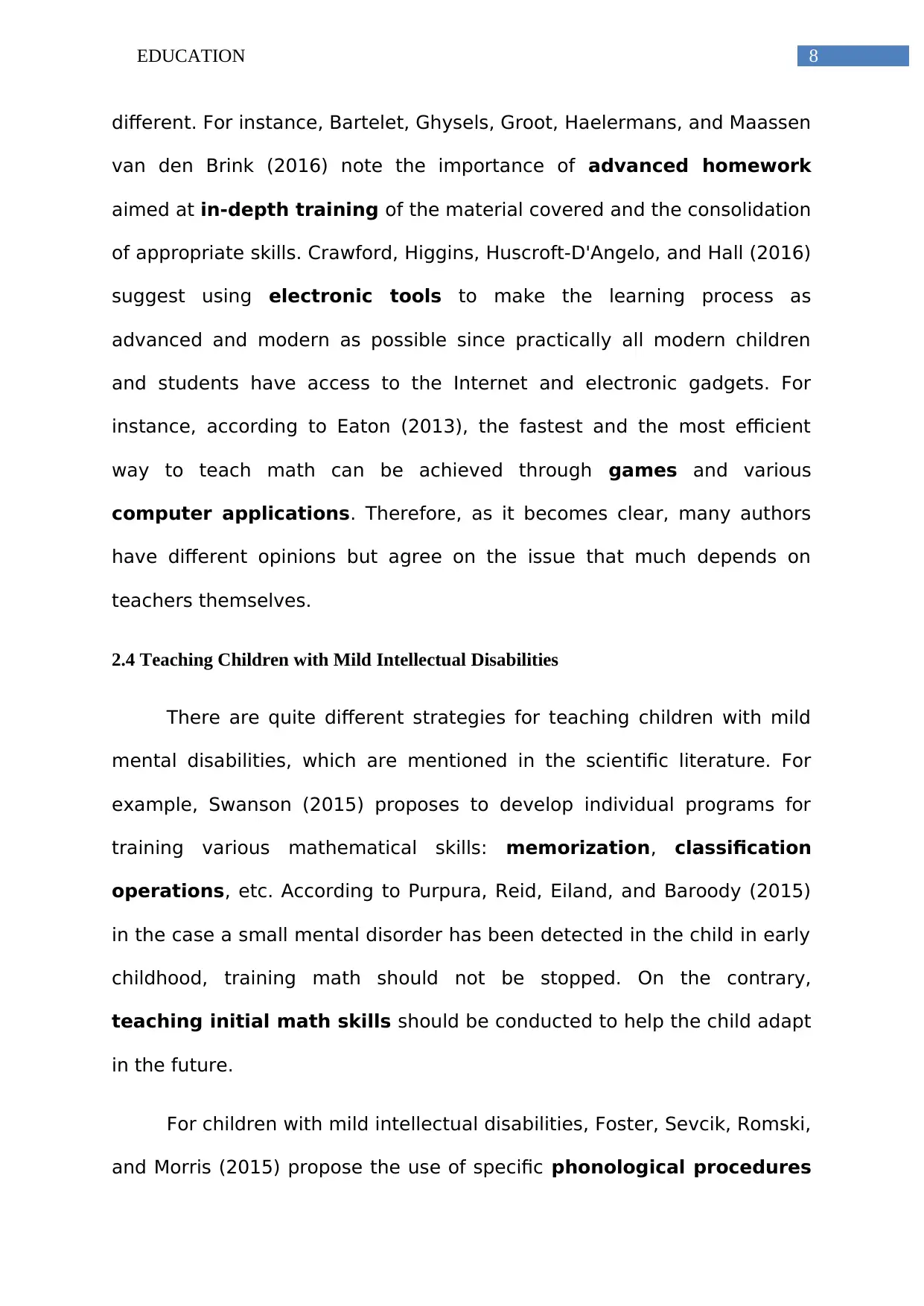
8EDUCATION
different. For instance, Bartelet, Ghysels, Groot, Haelermans, and Maassen
van den Brink (2016) note the importance of advanced homework
aimed at in-depth training of the material covered and the consolidation
of appropriate skills. Crawford, Higgins, Huscroft-D'Angelo, and Hall (2016)
suggest using electronic tools to make the learning process as
advanced and modern as possible since practically all modern children
and students have access to the Internet and electronic gadgets. For
instance, according to Eaton (2013), the fastest and the most efficient
way to teach math can be achieved through games and various
computer applications. Therefore, as it becomes clear, many authors
have different opinions but agree on the issue that much depends on
teachers themselves.
2.4 Teaching Children with Mild Intellectual Disabilities
There are quite different strategies for teaching children with mild
mental disabilities, which are mentioned in the scientific literature. For
example, Swanson (2015) proposes to develop individual programs for
training various mathematical skills: memorization, classification
operations, etc. According to Purpura, Reid, Eiland, and Baroody (2015)
in the case a small mental disorder has been detected in the child in early
childhood, training math should not be stopped. On the contrary,
teaching initial math skills should be conducted to help the child adapt
in the future.
For children with mild intellectual disabilities, Foster, Sevcik, Romski,
and Morris (2015) propose the use of specific phonological procedures
different. For instance, Bartelet, Ghysels, Groot, Haelermans, and Maassen
van den Brink (2016) note the importance of advanced homework
aimed at in-depth training of the material covered and the consolidation
of appropriate skills. Crawford, Higgins, Huscroft-D'Angelo, and Hall (2016)
suggest using electronic tools to make the learning process as
advanced and modern as possible since practically all modern children
and students have access to the Internet and electronic gadgets. For
instance, according to Eaton (2013), the fastest and the most efficient
way to teach math can be achieved through games and various
computer applications. Therefore, as it becomes clear, many authors
have different opinions but agree on the issue that much depends on
teachers themselves.
2.4 Teaching Children with Mild Intellectual Disabilities
There are quite different strategies for teaching children with mild
mental disabilities, which are mentioned in the scientific literature. For
example, Swanson (2015) proposes to develop individual programs for
training various mathematical skills: memorization, classification
operations, etc. According to Purpura, Reid, Eiland, and Baroody (2015)
in the case a small mental disorder has been detected in the child in early
childhood, training math should not be stopped. On the contrary,
teaching initial math skills should be conducted to help the child adapt
in the future.
For children with mild intellectual disabilities, Foster, Sevcik, Romski,
and Morris (2015) propose the use of specific phonological procedures
⊘ This is a preview!⊘
Do you want full access?
Subscribe today to unlock all pages.

Trusted by 1+ million students worldwide

9EDUCATION
aimed at accelerating the assimilation of certain mathematical
phenomena and training prior knowledge. In general, this method is quite
innovative because children not only learn the basics but also train
particular cognitive skills that are necessary for ordinary life. Thus,
Duncan (2017) offers to transform classes into a full-fledged game
where the child has the right to choose and can, together with parents or
teachers, engage in the basics of math through fascinating activities. A
slightly different approach is suggested by Cozad and Riccomini (2016)
who consider digital-based work with children with some mental
disabilities as one of the primary sources of gaining important knowledge,
monitoring the performance of students, and adjusting the learning
process in parallel. One of the useful skills that can be practiced with
children of almost any level of ability is teaching the basics of addition
and subtraction (Wise, 2016). Such work can certainly be conducted by
almost any child and at the same time will be of significant benefit to the
further learning process.
2.5 Cognitive Strategies to Involve Children in Studying Math Skills
One of the ways to help children who have difficulties with
mathematics is to use certain cognitive strategies (Bugden, DeWind, &
Brannon, 2016). The effectiveness of this approach to learning is
confirmed by quite a few authors. For example, Özsoy and Ataman (2017)
claim that honing specific skills contributes to faster further response to
similar tasks and thereby helps the child. The task of a qualified teacher,
as Chandran (2015) remarks, is to help children cope with anxiety caused
aimed at accelerating the assimilation of certain mathematical
phenomena and training prior knowledge. In general, this method is quite
innovative because children not only learn the basics but also train
particular cognitive skills that are necessary for ordinary life. Thus,
Duncan (2017) offers to transform classes into a full-fledged game
where the child has the right to choose and can, together with parents or
teachers, engage in the basics of math through fascinating activities. A
slightly different approach is suggested by Cozad and Riccomini (2016)
who consider digital-based work with children with some mental
disabilities as one of the primary sources of gaining important knowledge,
monitoring the performance of students, and adjusting the learning
process in parallel. One of the useful skills that can be practiced with
children of almost any level of ability is teaching the basics of addition
and subtraction (Wise, 2016). Such work can certainly be conducted by
almost any child and at the same time will be of significant benefit to the
further learning process.
2.5 Cognitive Strategies to Involve Children in Studying Math Skills
One of the ways to help children who have difficulties with
mathematics is to use certain cognitive strategies (Bugden, DeWind, &
Brannon, 2016). The effectiveness of this approach to learning is
confirmed by quite a few authors. For example, Özsoy and Ataman (2017)
claim that honing specific skills contributes to faster further response to
similar tasks and thereby helps the child. The task of a qualified teacher,
as Chandran (2015) remarks, is to help children cope with anxiety caused
Paraphrase This Document
Need a fresh take? Get an instant paraphrase of this document with our AI Paraphraser

10EDUCATION
by difficulties and assist them in adapting the scientific environment that
is new for them.
Specific interventions are offered by Musti-Rao and Plati (2015) who
consider several ways of teaching, including both self-study and teacher-
led lessons. Thus, Liu, Kallai, Schunn, and Fiez (2015) also talk about
individual training of skills and suggest improving mathematical fluency
by using computer-based education. However, this method is partially
challenged by Powell and Fuchs (2015) who see successful work only in an
individual approach to each student and are confident that all
implementations should be conducted under the direction of a responsible
teacher. Perhaps, that is why Clements and Sarama (2016) conduct a
positive correlation between the cognitive skills of children and their
ability to study exact sciences. In other words, the higher the motivation
and preparedness of a child are, the more likely it is that his or her
success in mathematics will be high enough.
2.6 Alternative Measures
As alternative ways to improve students’ mathematical skills,
different mechanisms can be used. For instance, Brendefur et al. (2015)
suggest referring to a special assessment system that is more relevant
for older children and can also be applied in higher education. With the
help of such a mechanism, the student can get full information about his
or her problem topics and pay extra attention to specific rules for
improving the learning outcome. Reisener, Dufrene, Clark, Olmi, and
Tingstrom (2016) propose to use visual aids and other digital tools that
by difficulties and assist them in adapting the scientific environment that
is new for them.
Specific interventions are offered by Musti-Rao and Plati (2015) who
consider several ways of teaching, including both self-study and teacher-
led lessons. Thus, Liu, Kallai, Schunn, and Fiez (2015) also talk about
individual training of skills and suggest improving mathematical fluency
by using computer-based education. However, this method is partially
challenged by Powell and Fuchs (2015) who see successful work only in an
individual approach to each student and are confident that all
implementations should be conducted under the direction of a responsible
teacher. Perhaps, that is why Clements and Sarama (2016) conduct a
positive correlation between the cognitive skills of children and their
ability to study exact sciences. In other words, the higher the motivation
and preparedness of a child are, the more likely it is that his or her
success in mathematics will be high enough.
2.6 Alternative Measures
As alternative ways to improve students’ mathematical skills,
different mechanisms can be used. For instance, Brendefur et al. (2015)
suggest referring to a special assessment system that is more relevant
for older children and can also be applied in higher education. With the
help of such a mechanism, the student can get full information about his
or her problem topics and pay extra attention to specific rules for
improving the learning outcome. Reisener, Dufrene, Clark, Olmi, and
Tingstrom (2016) propose to use visual aids and other digital tools that

11EDUCATION
can show the peculiarities of certain mathematical calculations outside
the box, that is, through comparisons with other scientific fields.
Finally, Szkudlarek and Brannon (2017) consider a rather old
mechanism for training mathematical fluency, resorting exclusively to the
help of numbers and without the use of language. This method can seem
quite difficult to study, especially at the initial stage. Nevertheless, as
practice shows, the cognitive nature of the human is specific enough, and
such a method of learning can be very successful (Szkudlarek and
Brannon, 2017). Thus, both alternative and traditional methods can be
effective, and it is essential to responsibly approach work and not be
afraid to resort to different ways of training in order to help children,
adolescents, and adults to better adapt to the scientific environment.
2.7: Scaffolding:
Scaffolding utilizes a range of teaching approaches that can help the
student to develop their academic skills, and help them understand their
subjects and also provide more independence in the learning process. The
term ‘scaffolding’ can be understood as a metaphor that highlights a
process in which the teacher provides temporary support to the students
which are repeated successively supporting the development of a higher
degree of comprehension and acquisition of skills which can be achieved
independently by the students (Saye et al., 2017). The structure is similar
to physical scaffolding in the process of incremental removal of support,
once they are needed no longer, slowly shifting the responsibility of
learning on the student. This strategy has been considered to be an
can show the peculiarities of certain mathematical calculations outside
the box, that is, through comparisons with other scientific fields.
Finally, Szkudlarek and Brannon (2017) consider a rather old
mechanism for training mathematical fluency, resorting exclusively to the
help of numbers and without the use of language. This method can seem
quite difficult to study, especially at the initial stage. Nevertheless, as
practice shows, the cognitive nature of the human is specific enough, and
such a method of learning can be very successful (Szkudlarek and
Brannon, 2017). Thus, both alternative and traditional methods can be
effective, and it is essential to responsibly approach work and not be
afraid to resort to different ways of training in order to help children,
adolescents, and adults to better adapt to the scientific environment.
2.7: Scaffolding:
Scaffolding utilizes a range of teaching approaches that can help the
student to develop their academic skills, and help them understand their
subjects and also provide more independence in the learning process. The
term ‘scaffolding’ can be understood as a metaphor that highlights a
process in which the teacher provides temporary support to the students
which are repeated successively supporting the development of a higher
degree of comprehension and acquisition of skills which can be achieved
independently by the students (Saye et al., 2017). The structure is similar
to physical scaffolding in the process of incremental removal of support,
once they are needed no longer, slowly shifting the responsibility of
learning on the student. This strategy has been considered to be an
⊘ This is a preview!⊘
Do you want full access?
Subscribe today to unlock all pages.

Trusted by 1+ million students worldwide
1 out of 36
Related Documents
Your All-in-One AI-Powered Toolkit for Academic Success.
+13062052269
info@desklib.com
Available 24*7 on WhatsApp / Email
![[object Object]](/_next/static/media/star-bottom.7253800d.svg)
Unlock your academic potential
Copyright © 2020–2025 A2Z Services. All Rights Reserved. Developed and managed by ZUCOL.





